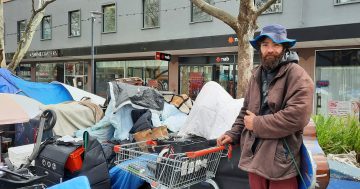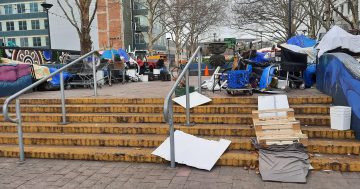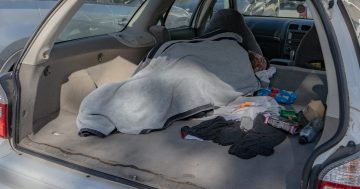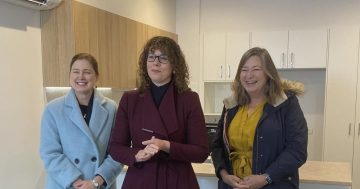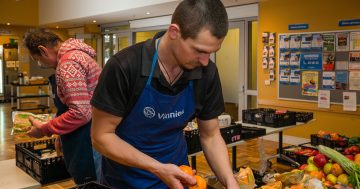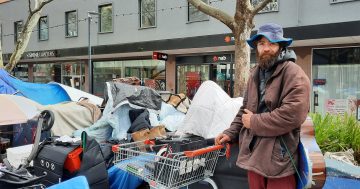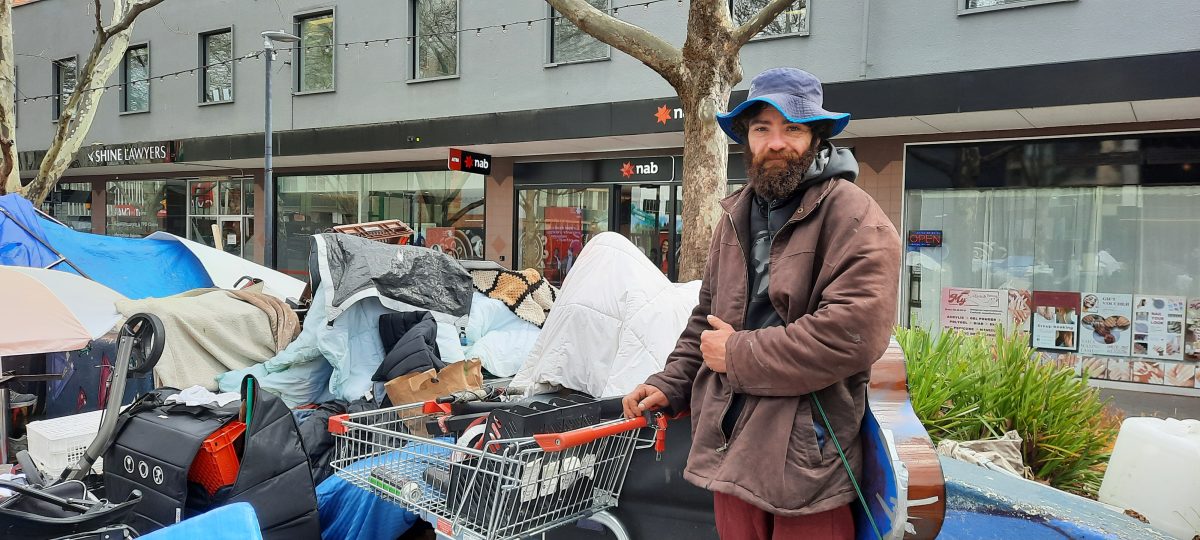
Homeless man Daniel at the camp in Petrie Plaza, City. Photos: Ian Bushnell.
Under-resourced homelessness services are struggling to cope with demand across Canberra as a sprawling camp in a prominent part of the CBD throws a spotlight on a surge in rough sleepers.
The camp of homeless people in Petrie Plaza near the carousel has only made visible a situation that is occurring across Canberra, according to Vinnies CEO Lucy Hohnen.
The camp – built from tarpaulins, old furniture, crates and assorted paraphernalia – is home to four people, but it is believed that up to 10 may be there from time to time.
Ms Hohnen said the four were known to Vinnies and its Street to Home service had engaged with them in a bid to find suitable shelter, but she could not say how long this would take, given there are often trust and mental health issues.
Homes and New Suburbs Minister Yvette Berry acknowledged it was a confronting scene for city visitors and nearby businesses, but pleaded for the public to be patient as services dealt with a complex situation.
“I understand for some people that’s frustrating, particularly for those businesses around the place, and that for others it’s distressing, seeing people sleeping rough and being in those kinds of circumstances,” she said.
“But my message is that we are doing everything we can to support these people where they are and moving them on to much more suitable accommodation, and finding them a home and working with them on a range of different complex issues that they are experiencing.”
Ms Berry said the government would face even more of an outcry if it had moved these people on.
She said that would be just moving the problem somewhere else.
“We want to make sure that we have a sustainable solution to this, and that’s just going to take a little bit more time,” Ms Berry said.
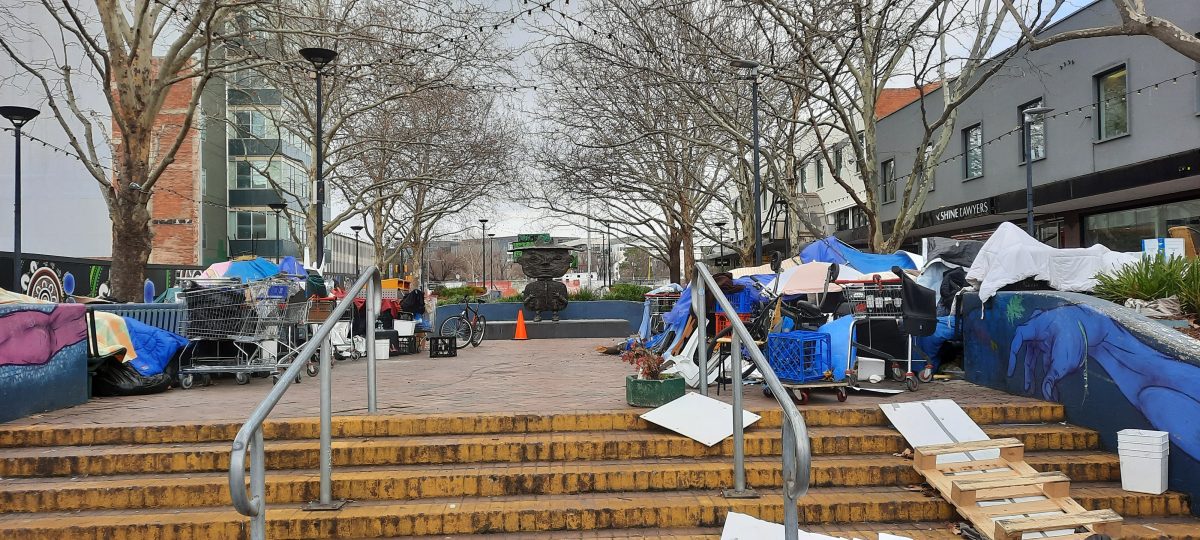
At least four people, but possibly up to 10, are living in the camp in Petrie Plaza.
Ms Hohnen said all homelessness services were stretched with an upsurge in numbers, not enough staff, especially mental health workers, and housing.
She said that with more mental health workers, services would be able to avert crises and make inroads for most people.
Street to Home had about 20 on its waiting list, while Vinnies’ men’s crisis accommodation, Samaritan House, had 31, reflecting the increase in rough sleepers across Canberra.
Ms Hohnen said the ACT Government’s public housing build was not ambitious enough and properties were not coming online fast enough.
“Until those properties are on online, we need more investment into homelessness services,” she said.
“If we’re holding this crisis of growing homelessness, against the backdrop of not enough properties coming along fast enough, then we can’t hold it.”
But services like Street to Home do work, with Ms Hohnen saying that once properties become available, the process can be smooth.
She said that last year, Vinnies supported 91 rough sleepers into housing, 28 per cent more than the previous year.
“What we need is the housing at the other end with that wraparound service to support people to maintain those tenancies,” Ms Hohnen said.
Ms Berry acknowledged that the ACT, like elsewhere, was playing catch-up with social housing and services needed more mental health workers, but these were hard to come by.
“We don’t have enough housing and support for particularly complex lives like these people, so those are the kinds of things that I’m working on with the sector,” she said.
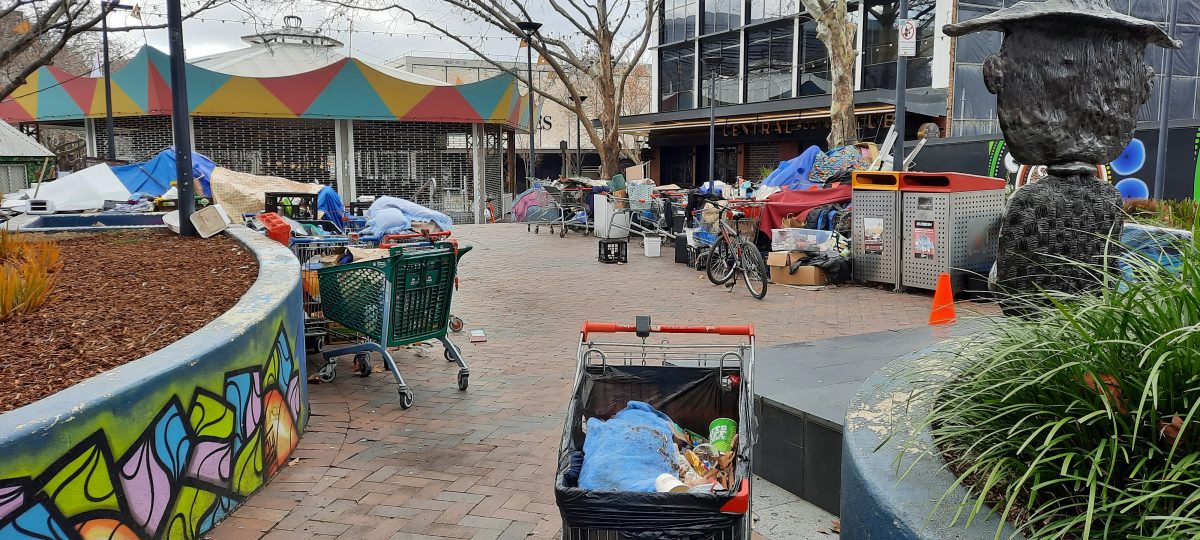
The government is urging patience as services work with the camp’s inhabitants.
Both Ms Berry and Ms Hohnen said the cost of living crisis had taken a toll on people, and the kinds of people sleeping rough varied greatly, although they differed on whether many were new to Canberra.
Ms Berry noted that some individuals who moved to Canberra during the warmer months seemed to be staying longer than usual due to the available support.
Ms Hohnen did not know how many people may have returned to the streets after previous stints in accommodation.
She said it was difficult to know how many rough sleepers there were in Canberra because the census figure of 1700 homeless also covered couch surfers and included people who wanted to be counted.
Some rough sleepers were virtually invisible with no identification documents, a challenge that case workers had to meet first so they could set people on the path to a roof over their heads.
Despite all the challenges, Ms Hohnen said there could be fantastic results, and the amazing thank-you letters they received made it all worthwhile.
“But it’s tough at the minute, pretty tough, but it can be done,” she said.
“When people get housing, then they can sort out all the other challenges in their life.”
Daniel is one of the four people living in Petrie Plaza. He did not provide much detail about his life but said he had been homeless for about two years after a bout in hospital and an accident.
He did not know how long they would stay at Petrie Plaza.
Daniel said it was hard to find a permanent place, but he was used to living on the streets.
They tried to keep the camp tidy and used the public toilets nearby.
Daniel said that people had tried to help him find shelter and had their numbers, but “that goes wrong sometimes”.
OneLink provides information and connections for support services in the ACT, including services for families and young people, and services for people who are homeless or at risk of homelessness.
OneLink is a service provided by Woden Community Service with assistance from the ACT Government.












